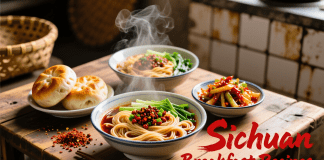Himalayan Tartary Buckwheat Recipes: Healthy & Flavorful
Discover the nutritional powerhouse of himalayan tartary buckwheat recipes and explore a world of delicious and healthy recipes. This ancient grain is packed with nutrients, making it an excellent addition to a balanced diet. Rich in protein, fiber, and antioxidants, it offers numerous health benefits, from improving heart health to aiding in weight management.

Incorporating gluten-free buckwheat meals into your daily routine can be both easy and exciting. With its unique flavor and versatility, you can create a variety of dishes, from hearty breakfast bowls to satisfying dinners. Whether you’re looking for healthy buckwheat recipes or simply want to diversify your meals, Himalayan Tartary buckwheat is an excellent choice.
Key Takeaways
- Explore the nutritional benefits of Himalayan Tartary buckwheat
- Discover healthy and flavorful recipe ideas
- Learn how to incorporate gluten-free buckwheat meals into your diet
- Understand the versatility of buckwheat in various dishes
- Find inspiration for healthy eating with buckwheat recipes
What Is Himalayan Tartary Buckwheat?
Himalayan Tartary buckwheat, a pseudocereal native to the Himalayan regions, is gaining popularity for its nutritional benefits and unique flavor profile. This ancient grain has been a staple in traditional Himalayan diets for centuries, valued for its hardiness and nutritional density. Its cultivation in high-altitude regions contributes to its distinct nutritional profile.
Origin and Unique Properties
Tartary buckwheat is known for its high content of rutin, a flavonoid with significant antioxidant properties. Unlike common buckwheat, Tartary buckwheat has a stronger flavor and is more bitter, which can be managed through proper cooking techniques. Some of its unique properties include:
- High antioxidant content
- Rich in rutin and other flavonoids
- Gluten-free, making it suitable for those with dietary restrictions
Nutritional Profile Compared to Common Buckwheat
When comparing Tartary buckwheat to common buckwheat, several nutritional advantages become apparent. Tartary buckwheat contains a higher amount of antioxidants and rutin, contributing to its enhanced health benefits. Key nutritional comparisons include:
- Higher rutin content
- Greater antioxidant capacity
- Similar protein and fiber content
Cooking with Tartary buckwheat not only enhances the nutritional value of meals but also introduces a unique flavor profile that can be leveraged in various healthy recipes. Its health benefits make it a valuable addition to a balanced diet, supporting overall well-being.
Health Benefits of Himalayan Tartary Buckwheat
Rich in essential nutrients, Himalayan Tartary buckwheat offers several health advantages. This ancient grain is packed with nutrients that can enhance overall well-being.
Rich Source of Rutin and Antioxidants
Himalayan Tartary buckwheat is an exceptional source of rutin, a powerful antioxidant that helps protect against cell damage and inflammation. The high antioxidant content in this buckwheat variety can help mitigate oxidative stress, promoting better health.
Gluten-Free Properties for Dietary Restrictions
Being naturally gluten-free, Himalayan Tartary buckwheat is an excellent option for individuals with gluten intolerance or celiac disease. This makes it a versatile ingredient for various dietary needs.
Blood Sugar Management and Other Health Advantages
Research suggests that incorporating Himalayan Tartary buckwheat into one’s diet can help manage blood sugar levels. The fiber and antioxidants in this buckwheat can contribute to improved glucose metabolism.
| Nutritional Benefits | Description |
|---|---|
| High in Rutin | Protects against cell damage and inflammation |
| Gluten-Free | Suitable for gluten intolerance or celiac disease |
| Blood Sugar Management | Helps in managing blood sugar levels |

Incorporating Himalayan Tartary buckwheat into your meals can be a simple yet effective way to boost your nutritional intake and enjoy its numerous health benefits.
Essential Tips for Cooking with Himalayan Tartary Buckwheat
To unlock the full potential of Himalayan Tartary buckwheat, understanding its unique characteristics is crucial. This ingredient, known for its robust nutritional profile, requires some special handling to bring out its best qualities.
Managing the Bitter Flavor Profile
Himalayan Tartary buckwheat is known for its bitter taste, which can be managed by proper soaking techniques. Soaking the buckwheat overnight can significantly reduce its bitterness, making it more palatable in various dishes. Additionally, roasting the buckwheat before cooking can enhance its flavor, providing a nuttier taste that complements a wide range of recipes.

Proper Soaking and Preparation Techniques
Soaking is a critical step in cooking Himalayan Tartary buckwheat. It’s recommended to soak it for at least 8 hours or overnight. After soaking, thorough rinsing is necessary to remove any remaining bitterness. For preparation, the buckwheat can be boiled or steamed, similar to rice or quinoa, making it a versatile ingredient for various meals.
Where to Find Himalayan Tartary Buckwheat
Himalayan Tartary buckwheat can be found in health food stores or online retailers that specialize in organic or specialty grains. When purchasing, look for products that are labeled as organic or non-GMO to ensure quality.
By following these tips, you can easily incorporate Himalayan Tartary buckwheat into your cooking, enjoying its nutritional benefits and unique flavor.
Delicious Himalayan Tartary Buckwheat Recipes for Breakfast
Himalayan Tartary buckwheat is a versatile ingredient that can be used to create a variety of healthy breakfast dishes. Its nutty flavor and high nutritional value make it an excellent addition to morning meals.
Tartary Buckwheat Pancakes with Berries
Start your day with fluffy Tartary Buckwheat Pancakes topped with fresh berries. The buckwheat adds a nutritious twist to a classic breakfast favorite. To make, simply mix buckwheat flour with eggs, milk, and a touch of honey, then top with your favorite fruits.
Nutritious Buckwheat Porridge Variations
Buckwheat porridge is another delicious breakfast option. You can customize it with various toppings such as nuts, seeds, or dried fruits. Experiment with different spices like cinnamon or nutmeg to enhance the flavor.
| Recipe | Ingredients | Prep Time |
|---|---|---|
| Tartary Buckwheat Pancakes | Buckwheat flour, eggs, milk, honey | 15 minutes |
| Buckwheat Porridge | Buckwheat groats, water or milk, nuts or seeds | 20 minutes |
Gluten-Free Buckwheat Muffins
For a quick breakfast on-the-go, try making Gluten-Free Buckwheat Muffins. They are perfect for busy mornings.
Blueberry Buckwheat Muffin Recipe
To make blueberry buckwheat muffins, combine buckwheat flour, blueberries, eggs, and a sweetener like honey. The result is a moist and flavorful muffin that’s both healthy and delicious.
These breakfast recipes showcase the versatility and nutritional benefits of Himalayan Tartary buckwheat. Whether you’re in the mood for pancakes, porridge, or muffins, buckwheat is a great ingredient to incorporate into your morning routine.
Savory Himalayan Tartary Buckwheat Recipes
Exploring the savory side of Himalayan Tartary buckwheat opens up a world of culinary possibilities. This ingredient’s unique nutty flavor makes it an excellent addition to a variety of dishes, from salads to hearty risottos.
Buckwheat Salad with Seasonal Vegetables
A simple yet flavorful way to enjoy Himalayan Tartary buckwheat is in a salad with seasonal vegetables. By combining cooked buckwheat with roasted vegetables, a tangy dressing, and fresh herbs, you create a nutritious and filling meal. The key is to balance the earthy flavor of the buckwheat with bright, fresh ingredients.
Hearty Buckwheat Risotto Alternatives
Tartary buckwheat can be used as a creative alternative to traditional risotto rice. By sautéing the buckwheat in olive oil and then simmering it with vegetable broth, you achieve a creamy, comforting dish. Adding mushrooms or asparagus can enhance the flavor and texture.
Tartary Buckwheat as a Rice Substitute
Using Himalayan Tartary buckwheat as a rice substitute is a great way to increase the nutritional value of your meals. It’s particularly good in pilafs, where it can be cooked with herbs and spices to absorb a lot of flavor.
Mushroom and Herb Buckwheat Pilaf
A delicious and savory recipe is to make a mushroom and herb buckwheat pilaf. By sautéing sliced mushrooms and chopped onions in olive oil, then adding cooked buckwheat, vegetable broth, and fresh herbs, you create a dish that’s both hearty and flavorful.
“The earthy flavor of mushrooms pairs perfectly with the nutty taste of Tartary buckwheat.”

Incorporating Himalayan Tartary buckwheat into your savory cooking not only adds variety to your meals but also boosts their nutritional value. Whether you’re making a salad, a risotto alternative, or a pilaf, this ingredient is sure to become a staple in your kitchen.
Baking with Himalayan Tartary Buckwheat Flour
Incorporating Himalayan Tartary buckwheat flour into your baking can elevate your gluten-free creations with its unique nutritional profile and flavor. This flour is particularly beneficial for those seeking gluten-free alternatives without compromising on taste or nutritional value.
Gluten-Free Bread and Pizza Crust
Using Himalayan Tartary buckwheat flour, you can create delicious gluten-free bread and pizza crusts that are not only healthy but also satisfying. The key is to blend it with other flours to achieve the right texture.
Cookies and Desserts with Buckwheat Flour
Tartary buckwheat flour adds a rich, nutty flavor to cookies and desserts, making them a hit with those who have gluten intolerance. It’s perfect for baking a variety of sweet treats.
Blending with Other Flours for Optimal Results
Blending Himalayan Tartary buckwheat flour with other gluten-free flours can enhance the texture and flavor of your baked goods. Experimenting with different ratios can help you achieve the desired outcome.
Tartary Buckwheat Banana Bread Recipe
A simple recipe to get you started is Tartary Buckwheat Banana Bread. It combines the nutritional benefits of buckwheat with the sweetness of bananas, making for a delicious and healthy treat.
By incorporating Himalayan Tartary buckwheat flour into your baking repertoire, you can create a variety of gluten-free meals that are both nutritious and delicious. Whether you’re making bread, cookies, or desserts, this flour is a versatile ingredient that can elevate your baking to the next level.
Quick and Easy Himalayan Tartary Buckwheat Recipes for Beginners
Starting your culinary journey with Himalayan Tartary buckwheat is simpler than you think with these quick recipes. For beginners, incorporating this nutritious ingredient into daily meals can be a delightful experience. Here are some easy and delicious ways to get started.
Simple 15-Minute Side Dishes
One of the easiest ways to enjoy Himalayan Tartary buckwheat is by preparing simple side dishes that can be ready in just 15 minutes. Sauteed buckwheat with garlic and herbs makes a great accompaniment to any meal. Simply toast the buckwheat in a pan with some olive oil, add minced garlic, and your choice of herbs, then serve hot.
Another quick option is to mix cooked buckwheat with roasted vegetables and a squeeze of lemon juice. This not only adds flavor but also packs a nutritional punch.
No-Bake Buckwheat Energy Balls
No-bake energy balls made with Himalayan Tartary buckwheat are perfect for a quick snack. Mix cooked buckwheat with nut butter, honey, and a pinch of salt, then roll into bite-sized balls. These energy balls are not only healthy but also easy to make and fun to eat.
One-Pot Buckwheat Meals
One-pot meals are a great way to simplify cooking while ensuring a nutritious meal. A hearty buckwheat stew can be made by sautéing onions, carrots, and celery in olive oil, then adding vegetable broth and buckwheat. Let it simmer until the buckwheat is tender, season with salt and pepper, and serve hot.
| Recipe | Prep Time | Cook Time |
|---|---|---|
| Sauteed Buckwheat | 5 minutes | 10 minutes |
| No-Bake Energy Balls | 10 minutes | 0 minutes |
| One-Pot Buckwheat Stew | 15 minutes | 25 minutes |
Conclusion: Embracing Himalayan Tartary Buckwheat in Your Kitchen
As we’ve explored the various Himalayan Tartary buckwheat recipes, it’s clear that this ingredient offers a wealth of nutritional benefits and culinary possibilities. From hearty breakfast porridges to savory salads and gluten-free baked goods, cooking with buckwheat can elevate your meals while catering to dietary needs.
Incorporating nutritious Tartary buckwheat meals into your daily routine can be simple and rewarding. With its rich source of rutin and antioxidants, Himalayan Tartary buckwheat is not only a healthy choice but also a versatile one, suitable for a variety of dishes.
By embracing Himalayan Tartary buckwheat in your kitchen, you’re not just adding a new ingredient to your pantry; you’re opening the door to a world of flavorful and nutritious possibilities. Whether you’re a seasoned chef or a culinary novice, the recipes and tips shared here will inspire you to get creative with this incredible ingredient.
FAQ
What is the difference between Himalayan Tartary buckwheat and common buckwheat?
Himalayan Tartary buckwheat has a higher rutin content and a more robust nutritional profile compared to common buckwheat, making it a more nutritious choice.
How do I manage the bitter flavor of Himalayan Tartary buckwheat?
To manage the bitter flavor, you can soak the buckwheat, use it in combination with other ingredients that balance out the flavor, or incorporate it into dishes with strong flavors.
Is Himalayan Tartary buckwheat gluten-free?
Yes, Himalayan Tartary buckwheat is gluten-free, making it an excellent option for those with gluten intolerance or sensitivity.
Can I use Himalayan Tartary buckwheat flour for baking?
Yes, Himalayan Tartary buckwheat flour can be used for baking, but it’s often recommended to blend it with other flours to achieve the best results.
How do I cook Himalayan Tartary buckwheat?
Cooking Himalayan Tartary buckwheat involves rinsing it, then boiling or steaming it until it’s tender. The ratio of water to buckwheat and cooking time may vary, so it’s best to follow specific recipe instructions.
What are the health benefits of consuming Himalayan Tartary buckwheat?
The health benefits include being rich in rutin and antioxidants, having gluten-free properties, and potentially aiding in blood sugar management, among other advantages.
Where can I find Himalayan Tartary buckwheat?
Himalayan Tartary buckwheat can be found in health food stores, specialty grocery stores, or online retailers that sell gluten-free or international ingredients.
Can I make desserts with Himalayan Tartary buckwheat flour?
Yes, Himalayan Tartary buckwheat flour can be used to make delicious desserts, such as cookies, cakes, and muffins, especially when blended with other flours.
Are there any simple recipes for beginners using Himalayan Tartary buckwheat?
Yes, simple recipes include making no-bake energy balls, one-pot buckwheat meals, and simple side dishes that can be prepared in under 15 minutes.













